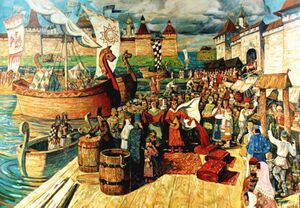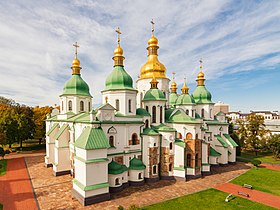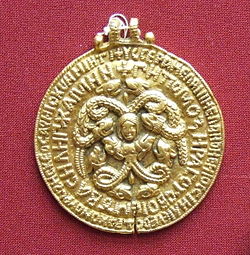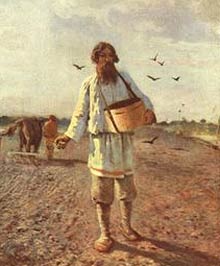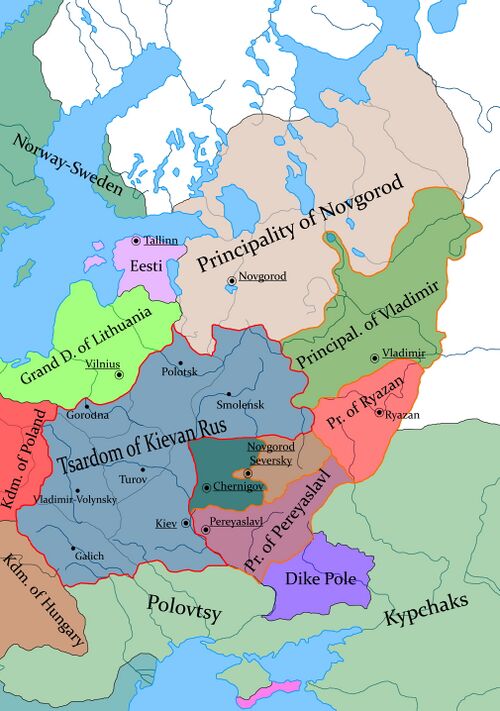Kiewan Rus: Difference between revisions
(→Cities) |
No edit summary |
||
| Line 4: | Line 4: | ||
|common_name = Kievan Rus | |common_name = Kievan Rus | ||
|image_flag = | |image_flag = | ||
[[File:Kievan | [[File:Kievan banner.png|200 px|frameless]] | ||
|image_coat = | |image_coat = | ||
[[File:Kievan Rus tamga.svg.png|150 px|frameless]] | [[File:Kievan Rus tamga.svg.png|150 px|frameless]] | ||
Revision as of 11:26, 22 May 2021
Tsardom of Kievan Rus Царство Київської Русі | |
|---|---|
| Capital and largest city | Kiev |
| Official languages | Old East Slavic |
| Recognised national languages | Old East Slavic Church Slavonic |
| Religion | Eastern Orthodox Church |
| Demonym(s) | Kievites |
| Government | Feudal absolute monarchy |
• Tsar | Daniel Romanovich from the Rurik dynasty |
| Legislature | Veche |
| History | |
• Established | 879 |
• Conquest of Khazar Khaganate | 965–969 |
| 988 | |
| early 11th century | |
| Area | |
• Total | 392,168 km2 (151,417 sq mi) |
• Water (%) | 6.1% |
| Population | |
• 1205 estimate | ~3,000,000 |
| Currency | Grivna (₴) |
Kievan Rus or Tsardom of Kievan Rus (Old East Slavic: Роусь, romanized: Rusĭ, or роусьскаѧ землѧ, romanized: rusĭskaę zemlę, "Rus' land") was a loose federation of East Slavic and Uralic peoples in Europe from the late 9th to the mid-13th century, under the reign of the Rurik dynasty, founded by the Varangian prince Rurik. At its greatest extent, in the mid-11th century, it stretched from the White Sea in the north to the Black Sea in the south and from the headwaters of the Vistula in the west to the Taman Peninsula in the east, uniting the majority of East Slavic tribes.
According to Rus Primary Chronicle, the first ruler to start uniting East Slavic lands into what has become known as Kievan Rus' was Prince Oleg (879–912). He extended his control from Novgorod south along the Dnieper river valley to protect trade from Khazar incursions from the east, and moved his capital to the more strategic Kiev. Sviatoslav I (died 972) achieved the first major expansion of Kievan Rus territorial control, fighting a war of conquest against the Khazars. Vladimir the Great (980–1015) introduced Christianity with his own baptism and, by decree, extended it to all inhabitants of Kiev and beyond. Kievan Rus reached its greatest extent under Yaroslav the Wise (1019–1054); his sons assembled and issued its first written legal code, the Russkaya Pravda ("Rus' Justice"), shortly after his death.
The state began to decline during the late 11th century, disintegrating into various rival regional powers. It was further weakened by economic factors, such as the collapse of Rus' commercial ties to the Byzantine Empire due to the decline of Constantinople and the accompanying diminution of trade routes through its territory. However, in 1202 Roman Mstislavich, the Grand Duke of Galicia and Volhynia, became the Grand Duke of Kiev and from 1203 to 1205 he conducted campaigns of conquest against the Principality of Polotsk and Smolensk. After that, he was crowned Tsar of the Second Kievan Rus, laying the foundation for the reunification of the lost lands.
Etymology
During its existence, Kievan Rus' was known as the "land of the Rus" (Old East Slavic: ро́усьскаѧ землѧ, from the ethnonym Ро́усь; Greek: Ῥῶς; Arabic: الروس ar-Rūs), in Greek as Ῥωσία, in Old French as Russie, Rossie, in Latin as Rusia or Russia (with local German spelling variants Ruscia and Ruzzia), and from the 12th century also Ruthenia or Rutenia. Various etymologies have been proposed, including Ruotsi, the Finnish designation for Sweden or Ros, a tribe from the middle Dnieper valley region. According to the prevalent theory, the name Rus', like the Proto-Finnic name for Sweden (*Ruotsi), is derived from an Old Norse term for "the men who row" (rods-) as rowing was the main method of navigating the rivers of Eastern Europe, and that it could be linked to the Swedish coastal area of Roslagen (Rus-law) or Roden, as it was known in earlier times. The name Rus' would then have the same origin as the Finnish and Estonian names for Sweden: Ruotsi and Rootsi.
In the Norse sources, the sagas, the principality is called Garðariki, and the peoples, according to Snorre Sturlason, are called Suiones, the confederation of Great Sviþjoð (Þjoð means people in Norse) were made up of the peoples along the Dniepr called Tanais that separated Asia and Europe (called Enea by Snorri Sturluson), all the way to the Baltics and Scandinavia.
History
Demographics
Society
Due to the expansion of trade and its geographical proximity, Kiev became the most important trade centre and chief among the communes; therefore the leader of Kiev gained political "control" over the surrounding areas. This princedom emerged from a coalition of traditional patriarchic family communes banded together in an effort to increase the applicable workforce and expand the productivity of the land. This union developed the first major cities in the Rus and was the first notable form of self-government. As these communes became larger, the emphasis was taken off the family holdings and placed on the territory that surrounded. This shift in ideology became known as the verv'.
In the 11th and the 12th centuries, the princes and their retinues, which were a mixture of Slavic and Scandinavian elites, dominated the society of Kievan Rus'. Leading soldiers and officials received income and land from the princes in return for their political and military services. Kievan society lacked the class institutions and autonomous towns that were typical of Western European feudalism. Nevertheless, urban merchants, artisans and labourers sometimes exercised political influence through a city assembly, the veche (council), which included all the adult males in the population. In some cases, the veche either made agreements with their rulers or expelled them and invited others to take their place. At the bottom of society was a stratum of slaves. More important was a class of tribute-paying peasants, who owed labour duty to the princes.
The change in political structure led to the inevitable development of the peasant class or smerds. The smerdy were free un-landed people that found work by labouring for wages on the manors that began to develop around 1031 as the verv' began to dominate socio-political structure. The smerdy were initially given equality in the Kievian law code; they were theoretically equal to the prince; so they enjoyed as much freedom as can be expected of manual labourers. However, in the 13th century, they slowly began to lose their rights and became less equal in the eyes of the law.
Religion
In 988, the Christian Church in Rus' territorially fell under the jurisdiction of the Ecumenical Patriarchate of Constantinople after it was officially adopted as the state religion. According to several chronicles after that date the predominant cult of Slavic paganism was persecuted.
The exact date of creation of the Kiev Metropolis is uncertain, as well as who was the first leader of the church. Predominantly it is considered that the first head was Michael I of Kiev, however some sources also claim Leontiy who is often placed after Michael or Anastas Chersonesos, became the first bishop of the Church of the Tithes. The first metropolitan to be confirmed by historical sources is Theopemp, who was appointed by Patriarch Alexius of Constantinople in 1038. Before 1015 there were five dioceses: Kiev, Chernihiv, Bilhorod, Volodymyr, Novgorod, and soon thereafter Yuriy-upon-Ros. The Kiev Metropolitan sent his own delegation to the Council of Bari in 1098.
By the mid 13th century, the dioceses of Kiev Metropolis (988) were as follows: Kiev (988), Pereyaslav, Chernihiv (991), Volodymyr-Volynsky (992), Turov (1005), Polotsk (1104), Novgorod (~990s), Smolensk (1137), Murom (1198), Peremyshl (1120), Halych (1134), Rostov (991), Bilhorod, Yuriy (1032). There also were dioceses in Zakarpattia and Tmutarakan.
Language
Cities and fortresses
Cities
Large cities had complex defensive systems. Detinets - the city center - was defended separately. As a rule, one or two fortified roundabout cities adjoined it. The fortifications covered a significant area of several tens of hectares; in case of danger, not only the population of the city, but also its environs could hide behind them. Each such city was also a princely residence with its own princely court (up to 2000 m2). At the same time, in a number of cities, such as Novgorod, Kiev, Ryazan and Smolensk, there were also courtyards of ordinary citizens (up to 600 m2). The presence of courtyards had a significant impact on the urban planning. As a rule, one or two streets ran along rivers and were crossed by small streets and lanes. Another characteristic feature of the Rus city of the XI-XIII centuries was the obligatory presence of a church or temple. In ancient Rus cities, there were from two or three, to several dozen churches. Monasteries could be located outside the city. Unfortified settlements adjoined the city fortifications. The total area of a large Old Rus city often exceeded 100 hectares.
The following functions of the city in the Old Rus state are distinguished: military, economic, administrative, ideological and cultural. In his opinion, from a social point of view, the ancient Russian city was a place of concentration of the feudal nobility.
Fortresses
Economy
Monetary system
The formation of monetary circulation in the Slavic lands of Eastern Europe occurs at the turn of the VIII-IX centuries, when active trade of Northern and Eastern Europe with the countries of the Caliphate began. Eastern European countries, deprived of large ore reserves of coinage, actively imported silver. In the first third of the 9th century, coins that were minted in the African centers of the Caliphate and which came to Russia through the Caucasian and Central Asian trade routes became widespread in Ancient Rus. Since the 830s, Asian dirhams have become widespread.
In the second half of the 10th century, two territorial Russian systems appeared, which were defined against the background of different gravitation of the northern and southern regions to international markets. The main means of circulation of Southern Russia (Kiev, Chernigov, Smolensk, etc.) were cuttings from dirhams weighing 1.63 grams, which make up 1/200 of a Byzantine liter. Similar cuttings were used in the lands of Northern Russia, but their weight was 1.04 grams, or 1/200 of a silver hryvnia. An important monument of this system is the spherical weight weights used in the northern regions of Russia for weighing silver coins. After the extinction of the influx of eastern coins to Russia due to the weakening of the Caliphate, they were replaced by commodity-money. At the turn of the 10th-11th centuries, during the times of Vladimir and Svyatopolk, an attempt was made to mint their own coins. However, it was soon discontinued due to the lack of a raw material base.
In the Kiev, Western European denarii of Germanic, English and Scandinavian coinage came to replace dirhams.
Agriculture
Agriculture of Ancient Rus was one of the foundations of its economy. A number of historians regarded it as the dominant branch of the ancient Rus economy. A special role in agriculture was played by the princely and boyar lands.
By the time the Old Rus state was formed, the sale of grain did not play a significant role in foreign trade. Most of the turnover was made up of hunting and forestry products: furs, wax and honey. Bread became "wealth", that is, the subject of trade exchange, much later. However, according to written sources, agriculture was the main occupation of the ancient Russian rural population. So, according to the "Tale of Bygone Years", the Vyatichi paid tribute to the Khazars by one coin from the plow, therefore, the plow was their main means of subsistence.
Religion also indirectly testifies to the important role of agriculture. The known facts about the pre-Christian religion of the Slavs speak mainly of an agricultural cult. The early history of Christianity in Rus confirms the agricultural character of the economy of the Slavs in the 9th-10th centuries. The folk Christianity of Rus almost did not bear on itself any essential signs of totemism. Christian concepts and ideas have replaced the elements of precisely the agricultural cult: spring was identified with the Mother of God, who came to the Annunciation on a plow, Saints Ilya, Yegoriy and Nikola turned into patrons of agricultural work. The Slavic calendar also speaks of agriculture as the economic basis of the life of ancient Russ society.
The difference in natural zones influenced agricultural practices and led to a noticeable difference between the north and south of the country in the field of agriculture. The steppe zone with rich black soil was open for cultivation. In the forest zone, in order to obtain a plot of arable land, it was first necessary to uproot the forest. In the transitional forest-steppe zone, it was possible to use tree-free plots of land even before the deforestation of the surrounding forest. According to archeology and written sources, from the 9th-10th centuries, arable farming has played a leading role even in the central parts of the territory inhabited by Eastern Slavs, and the plow and plow have become the main agricultural tools. In the Middle and Southern Dnieper region, a plowed farming system existed before. So, already early written sources distinguish between winter and spring crops, which speaks of sustainable arable farming, of a two-field, and, possibly, a three-field system. At the same time, the previous archaic forms of agriculture, primarily slash and burn, continued to be used in some regions for many subsequent centuries.
The period up to the 9th century, which preceded the formation of the Old Rus state, is characterized by widespread distribution in the northwest and west of soft wheat, barley and millet. Forage beans, peas, flax, and hemp were cultivated. Rye appears, initially spring. At the end of this period, winter rye appears. Archaeological materials from the 10th - first half of the 13th century are characterized by the same composition of cultures and an increase in the number of winter rye crops. The main crops of the previous period (wheat and barley) are pushed aside to the second or third places. More often, another new crop appears - oats. In the south, spelled, wheat and buckwheat were grown as the main crops. Under the three-field system, fiber crops suitable for weaving (flax and hemp), legumes (peas and lentils), and turnips were cultivated on separate fields.
Russkaya Pravda established fines for plowing land outside the established boundaries. The estates could belong to princes, boyars, churches and others. The managers of the princely and boyar estates were called tiuns, and the princely estates were also called ognischans. A separate part of the estate was called a "село"(village) (corresponding to a villa in the Carolingian Empire) and was managed by a village headman. The princely lands were cultivated by slaves and dependent workers - purchases, as well as hired workers - rank-and-file and freedmen - outcasts.


